EPSC-Shell Canada Sedimentology Field Trip 2014: Neogene Basins of Southeastern Spain
As part of EPSC 425 (Sediments to Sequences) and a coupled graduate course on sedimentary basins, 25 undergraduate students, 7 graduate students, and I traveled to southern Spain in March to visit the Neogene sedimentary basins of Almería Province, Andalucia. Home to the driest climate in western Europe and the sets of several movies (including The Good, the Bad, and the Ugly and Lawrence of Arabia), southeastern Andalucia has to be one of the best places in the world to run a sedimentology field trip. It helped that we enjoyed almost perfect weather, even as family and friends back home suffered through yet another frigid week!
Day 1. The 32 students and I met in Málaga, and after a few bumps in the road resulting from delayed flights, we set off for Alméria late Saturday morning. Due to the late start, we did not have time for any stops along the way, with the exception of lunch on the beach at Alumuñecar. We arrived in Carboneras after the sun had set and settled into our apartments that were to be our home for the next four nights—a stone's throw away from the Mediterranean.
Day 2. After an early start, we spent the day in the Sorbas basin, one of several small and geographically distinct sedimentary basins that flanks the basement uplifts in the region. Following an overview of this and the other basins in the area, we settled into an afternoon of investigating marginal marine sequences in the town of Sorbas. Here we saw tidal deltas, barrier island systems and accompanying lagoonal deposits, and fluvial sediments deposited in a basin influenced by rapid subsidence rates and glacioeustatic sea level fluctuations.
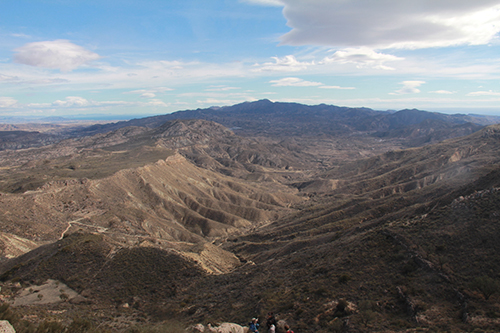 Taking it all in from the Cantona Hill overlook in the Sorbas Basin.
Taking it all in from the Cantona Hill overlook in the Sorbas Basin.
Day 3. We spent one more day in the Sorbas basin, this time focusing on the orbitally-driven cycles in the Abad and Yesares members (see photo below). The Yesares Member contains abundant gypsum deposited during the tail end of the Messinian salinity crisis, about 5 million years ago. While I had seen gypsum in the field before, never had I seen it so well developed, nor in such an interesting context within Earth's history. The immense 'gypsume supercones' especially impressed us. We finished off our day with a tour of caves carved out of the gypsum and associated marls.
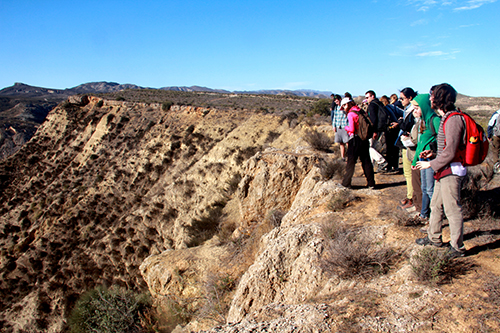 Morning view from the top of a plateau held up by gypsum of the basal Yesares (Messinian) Member.
Morning view from the top of a plateau held up by gypsum of the basal Yesares (Messinian) Member.
Day 4. We shifted or focus to the Tabernas basin, beginning in 'Little Hollywood' where we spent the morning scrambling about alluvial fan sediments deposited on the margin of the basin. We then descended into the depocentre of the basin, where we examined turbidites and other gravity flow sediments deposited in subaqueously carved canyons within a confined turbidite system. This is where undergraduate and graduate students alike learned that not all turbidites are created equal—that is, they do not obey the usual rules when deposited within confined systems, such as the small, fault-bound Neogene basins of southeastern Spain. In the late evening, we descended to the coast within the scenic Cabo de Gatas to have a look at Neogene volcanics associated with the opening of the Alboran Sea.
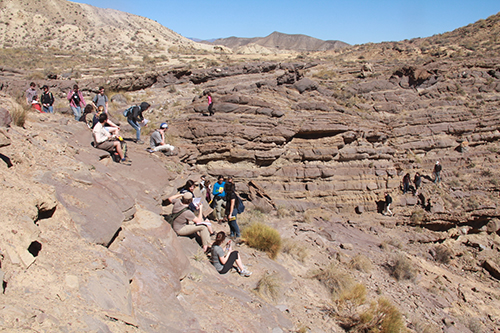 Investigating an oblique longitudinal view of a confined turbidite system, filling a canyon that had been carved into marls in the core of the Tabernas basin.
Investigating an oblique longitudinal view of a confined turbidite system, filling a canyon that had been carved into marls in the core of the Tabernas basin.
Day 5. After bidding a sad adieu to our seaside abode in Carboneras, we wound our way through the basins and mountains to the western margin of the Tabernas basin, where we met up with Fernando García García, a sedimentologist at the Universidad de Jaén who graciously offered to show us Gilbert deltas in the Tabernas and Guadix basins. At our first stop, we saw a series of Gibert delta systems deposited in a rapidly subsiding basin, which each delta system deposited during a separate glacioeustatic cycle. Due to the the rapid generation of accommodation space, the topsets here were very well developed and clogged with coarse sediments, including cobbles deposited in fluviodeltaic bars, but reworked by waves. After a lazy lunch in the sun, we relocated to the Guadix basin, which sits on the north side of the aptly named Sierra Nevada that includes the tallest peak in mainland Spain. Here we saw more glacioeustatically driven cycles, but this time developed on a tidally influenced, mixed carbonate-clastic ramp (see below). We then repaired to our hotel in Guadix, where most of us enjoyed a dinner of tapas.
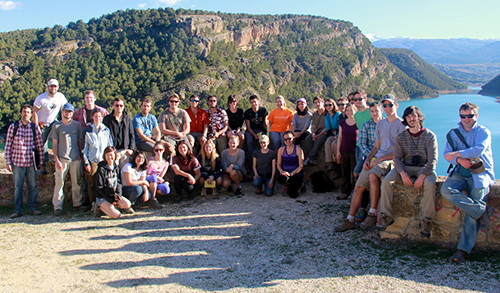 The group with Fernando (far left) sitting in front of the tidally influenced ramp cycles (uplifted following deposition, such that these are not foreslope deposits as proposed by some workers!). A sliver of The Sierra Nevada is visible in the background.
The group with Fernando (far left) sitting in front of the tidally influenced ramp cycles (uplifted following deposition, such that these are not foreslope deposits as proposed by some workers!). A sliver of The Sierra Nevada is visible in the background.
Day 6. This was our last day in the field. We spend the morning looking in more detail at the sediments deposited on the tidally influenced ramp on the margin of the Guadix basin. In the afternoo, we relocated to the northern part of the basin, where we investigated another Gilbert delta. This one, however, was deposited during an episode of forced regression resulting from uplift of flanking Mesozoic basement. The result was a fan delta system where the coarse-grained sediments were deposited in the bottomsets and foresets, along with shrinking foresets reflecting the shallowing of the basin. Great stuff!
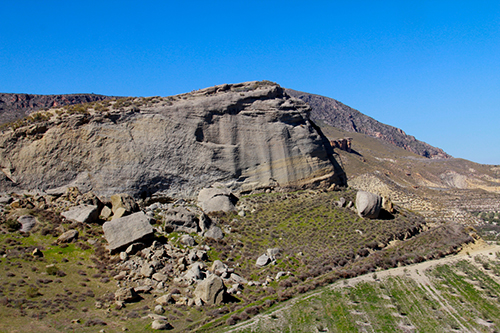 A Gilbert delta deposited on the uplifting flank of the Guadix basin, north of the Sierra Nevada. Notice the decreasing height of the foresets, reflecting infilling and shallowing of the basin. Also notice that the outcrop sits amid bucolic olive groves... not a bad field trip stop.
A Gilbert delta deposited on the uplifting flank of the Guadix basin, north of the Sierra Nevada. Notice the decreasing height of the foresets, reflecting infilling and shallowing of the basin. Also notice that the outcrop sits amid bucolic olive groves... not a bad field trip stop.
Day 7. After another tapas filled night, this time in Granada, we set off for Málaga. In an amazing stroke of luck, we all find our way out of tightly packed central Granada, without any visible damage to our four vans. Soon we were en route to Málaga. Here the group disbanded, with some of us returning promptly to Montréal, while others stretched out their stays on the Iberian Peninsula.